Abstract
1. The effects of calcitonin gene-related peptide (CGRP) and other vasoactive mediators of inflammation on blood flow in the synovial vessels and plasma protein extravasation into the knee (femoro-tibial) joint of the pentobarbitone-anaesthetized rat were measured. 2. Changes in synovial blood flow were estimated by 133xenon clearance from the synovial cavity. CGRP (0.1 pmol and 10 pmol) and prostaglandin E1 (PGE1; 3 pmol and 300 pmol) significantly increased clearance from the knee joint measured 5 min after intra-articular injection. Substance P (10 pmol) had no effect on synovial blood flow. 3. Intra-articular perfusion of the rat knee with CGRP at concentrations up to 0.1 mM, or PGE1 at concentrations up to 10 microM, did not increase plasma extravasation into the synovial cavity measured by accumulation of intravenously injected 125I-albumin in the perfusate. 4. Plasma extravasation into the knee was significantly increased by infusion of bradykinin (0.1 microM), 5-hydroxytryptamine (1 microM) and histamine (0.1 mM), compared with the contralateral joints in the same animals which were perfused with Tyrode solution. 5. Perfusion of the knee joint with substance P did not specifically induce 125I-labelled albumin accumulation in the synovial cavity even at doses that had systemic effects as observed by marked plasma extravasation into other tissues. 6. The increase in plasma extravasation induced by histamine (0.1 mM) was potentiated by co-infusion with CGRP (0.1 microM) and PGE1 (3 microM). However the response to a submaximal dose (0.1 microM) of bradykinin, which induced similar plasma extravasation to histamine (0.1 mM), was not increased by co-infusion with CGRP or PGE1.(ABSTRACT TRUNCATED AT 250 WORDS)
Full text
PDF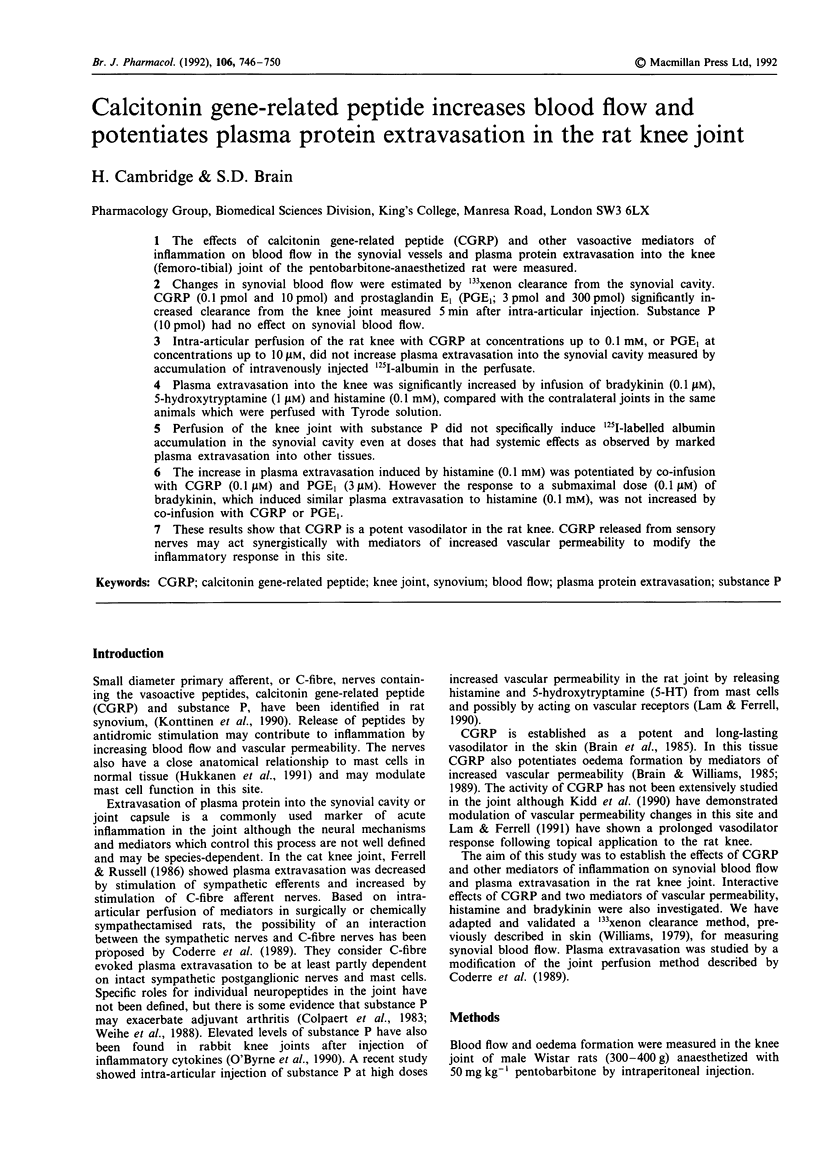
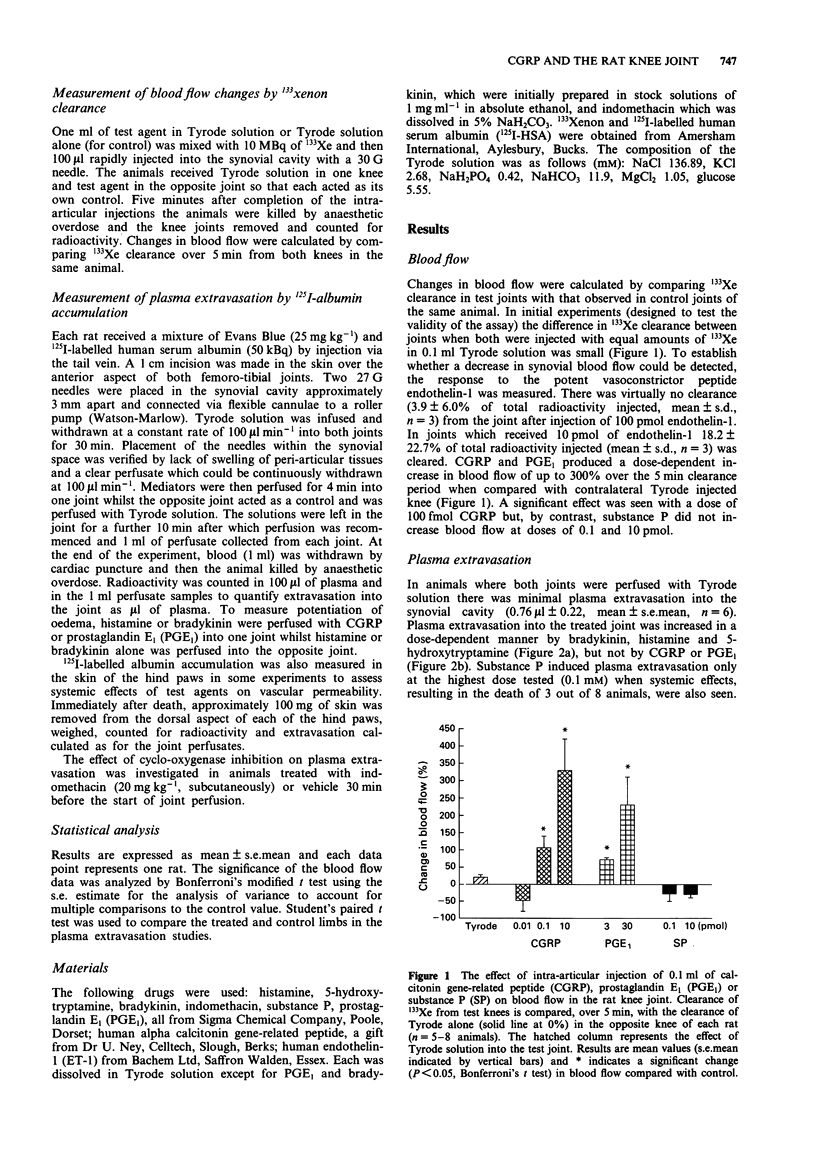
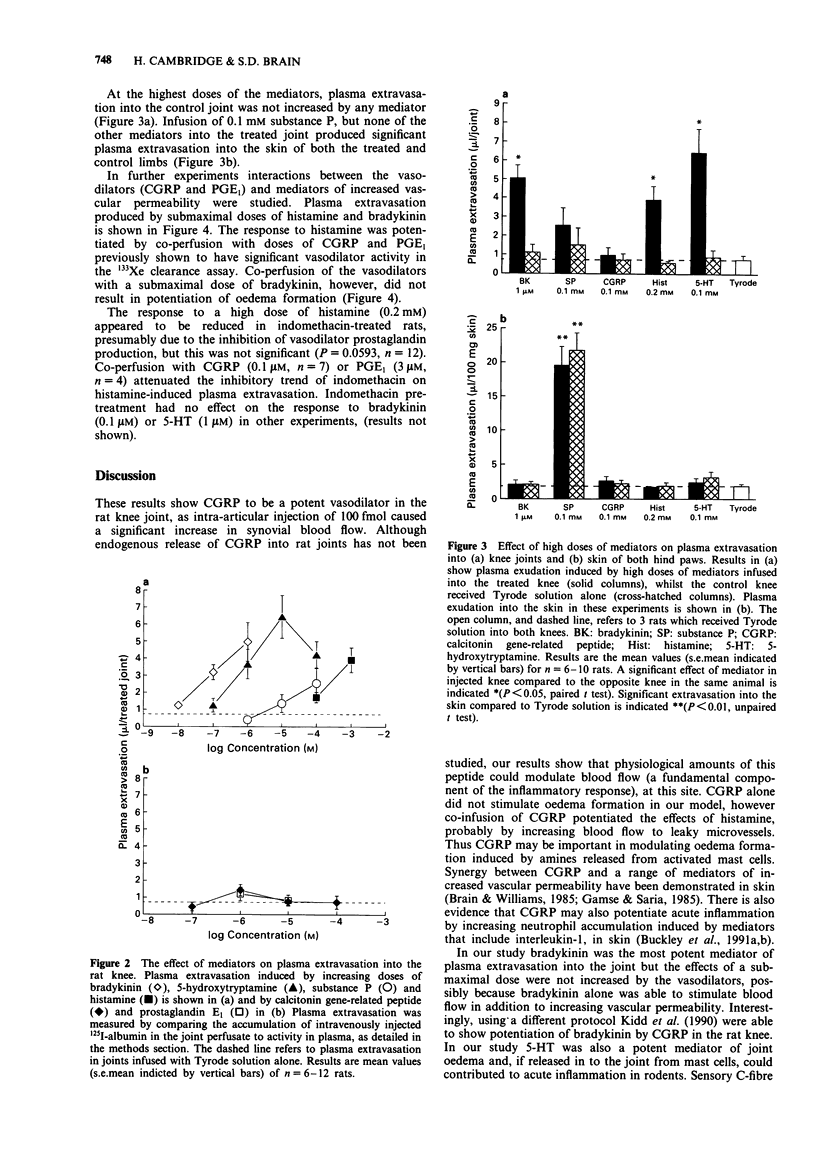
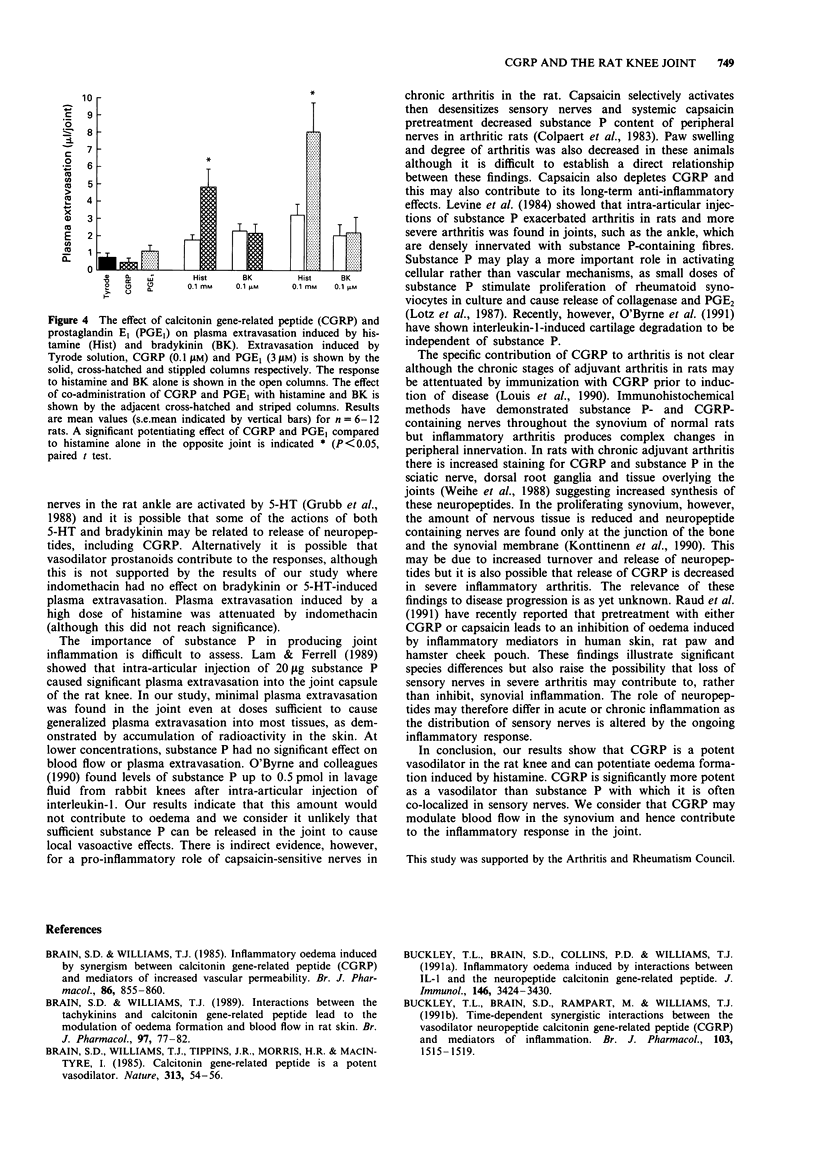
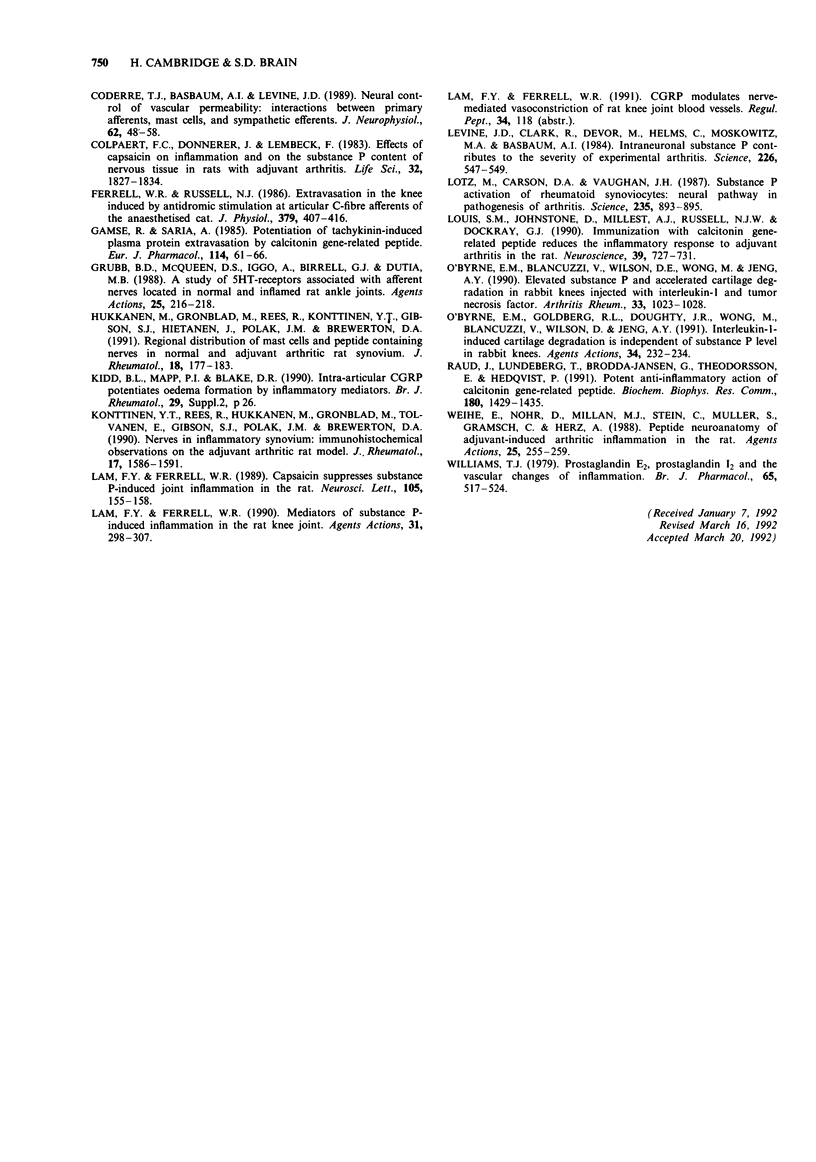
Selected References
These references are in PubMed. This may not be the complete list of references from this article.
- Brain S. D., Williams T. J. Inflammatory oedema induced by synergism between calcitonin gene-related peptide (CGRP) and mediators of increased vascular permeability. Br J Pharmacol. 1985 Dec;86(4):855–860. doi: 10.1111/j.1476-5381.1985.tb11107.x. [DOI] [PMC free article] [PubMed] [Google Scholar]
- Brain S. D., Williams T. J. Interactions between the tachykinins and calcitonin gene-related peptide lead to the modulation of oedema formation and blood flow in rat skin. Br J Pharmacol. 1989 May;97(1):77–82. doi: 10.1111/j.1476-5381.1989.tb11926.x. [DOI] [PMC free article] [PubMed] [Google Scholar]
- Brain S. D., Williams T. J., Tippins J. R., Morris H. R., MacIntyre I. Calcitonin gene-related peptide is a potent vasodilator. Nature. 1985 Jan 3;313(5997):54–56. doi: 10.1038/313054a0. [DOI] [PubMed] [Google Scholar]
- Buckley T. L., Brain S. D., Collins P. D., Williams T. J. Inflammatory edema induced by interactions between IL-1 and the neuropeptide calcitonin gene-related peptide. J Immunol. 1991 May 15;146(10):3424–3430. [PubMed] [Google Scholar]
- Buckley T. L., Brain S. D., Rampart M., Williams T. J. Time-dependent synergistic interactions between the vasodilator neuropeptide, calcitonin gene-related peptide (CGRP) and mediators of inflammation. Br J Pharmacol. 1991 Jun;103(2):1515–1519. doi: 10.1111/j.1476-5381.1991.tb09819.x. [DOI] [PMC free article] [PubMed] [Google Scholar]
- Coderre T. J., Basbaum A. I., Levine J. D. Neural control of vascular permeability: interactions between primary afferents, mast cells, and sympathetic efferents. J Neurophysiol. 1989 Jul;62(1):48–58. doi: 10.1152/jn.1989.62.1.48. [DOI] [PubMed] [Google Scholar]
- Colpaert F. C., Donnerer J., Lembeck F. Effects of capsaicin on inflammation and on the substance P content of nervous tissues in rats with adjuvant arthritis. Life Sci. 1983 Apr 18;32(16):1827–1834. doi: 10.1016/0024-3205(83)90060-7. [DOI] [PubMed] [Google Scholar]
- Ferrell W. R., Russell N. J. Extravasation in the knee induced by antidromic stimulation of articular C fibre afferents of the anaesthetized cat. J Physiol. 1986 Oct;379:407–416. doi: 10.1113/jphysiol.1986.sp016260. [DOI] [PMC free article] [PubMed] [Google Scholar]
- Gamse R., Saria A. Potentiation of tachykinin-induced plasma protein extravasation by calcitonin gene-related peptide. Eur J Pharmacol. 1985 Aug 7;114(1):61–66. doi: 10.1016/0014-2999(85)90520-5. [DOI] [PubMed] [Google Scholar]
- Grubb B. D., McQueen D. S., Iggo A., Birrell G. J., Dutia M. B. A study of 5-HT-receptors associated with afferent nerves located in normal and inflamed rat ankle joints. Agents Actions. 1988 Dec;25(3-4):216–218. doi: 10.1007/BF01965015. [DOI] [PubMed] [Google Scholar]
- Hukkanen M., Grönblad M., Rees R., Kottinen Y. T., Gibson S. J., Hietanen J., Polak J. M., Brewerton D. A. Regional distribution of mast cells and peptide containing nerves in normal and adjuvant arthritic rat synovium. J Rheumatol. 1991 Feb;18(2):177–183. [PubMed] [Google Scholar]
- Konttinen Y. T., Rees R., Hukkanen M., Grönblad M., Tolvanen E., Gibson S. J., Polak J. M., Brewerton D. A. Nerves in inflammatory synovium: immunohistochemical observations on the adjuvant arthritis rat model. J Rheumatol. 1990 Dec;17(12):1586–1591. [PubMed] [Google Scholar]
- Lam F. Y., Ferrell W. R. Capsaicin suppresses substance P-induced joint inflammation in the rat. Neurosci Lett. 1989 Oct 23;105(1-2):155–158. doi: 10.1016/0304-3940(89)90028-1. [DOI] [PubMed] [Google Scholar]
- Lam F. Y., Ferrell W. R. Mediators of substance P-induced inflammation in the rat knee joint. Agents Actions. 1990 Nov;31(3-4):298–307. doi: 10.1007/BF01997623. [DOI] [PubMed] [Google Scholar]
- Levine J. D., Clark R., Devor M., Helms C., Moskowitz M. A., Basbaum A. I. Intraneuronal substance P contributes to the severity of experimental arthritis. Science. 1984 Nov 2;226(4674):547–549. doi: 10.1126/science.6208609. [DOI] [PubMed] [Google Scholar]
- Lotz M., Carson D. A., Vaughan J. H. Substance P activation of rheumatoid synoviocytes: neural pathway in pathogenesis of arthritis. Science. 1987 Feb 20;235(4791):893–895. doi: 10.1126/science.2433770. [DOI] [PubMed] [Google Scholar]
- Louis S. M., Johnstone D., Millest A. J., Russell N. J., Dockray G. J. Immunization with calcitonin gene-related peptide reduces the inflammatory response to adjuvant arthritis in the rat. Neuroscience. 1990;39(3):727–731. doi: 10.1016/0306-4522(90)90256-4. [DOI] [PubMed] [Google Scholar]
- O'Byrne E. M., Blancuzzi V., Wilson D. E., Wong M., Jeng A. Y. Elevated substance P and accelerated cartilage degradation in rabbit knees injected with interleukin-1 and tumor necrosis factor. Arthritis Rheum. 1990 Jul;33(7):1023–1028. doi: 10.1002/art.1780330715. [DOI] [PubMed] [Google Scholar]
- O'Byrne E. M., Goldberg R. L., Doughty J. R., Wong M., Blancuzzi V., Wilson D., Jeng A. Y. Interleukin-1-induced cartilage degradation is independent of substance P level in rabbit knees. Agents Actions. 1991 Sep;34(1-2):232–234. doi: 10.1007/BF01993289. [DOI] [PubMed] [Google Scholar]
- Raud J., Lundeberg T., Brodda-Jansen G., Theodorsson E., Hedqvist P. Potent anti-inflammatory action of calcitonin gene-related peptide. Biochem Biophys Res Commun. 1991 Nov 14;180(3):1429–1435. doi: 10.1016/s0006-291x(05)81356-7. [DOI] [PubMed] [Google Scholar]
- Weihe E., Nohr D., Millan M. J., Stein C., Müller S., Gramsch C., Herz A. Peptide neuroanatomy of adjuvant-induced arthritic inflammation in rat. Agents Actions. 1988 Dec;25(3-4):255–259. doi: 10.1007/BF01965027. [DOI] [PubMed] [Google Scholar]
- Williams T. J. Prostaglandin E2, prostaglandin I2 and the vascular changes of inflammation. Br J Pharmacol. 1979 Mar;65(3):517–524. doi: 10.1111/j.1476-5381.1979.tb07860.x. [DOI] [PMC free article] [PubMed] [Google Scholar]


